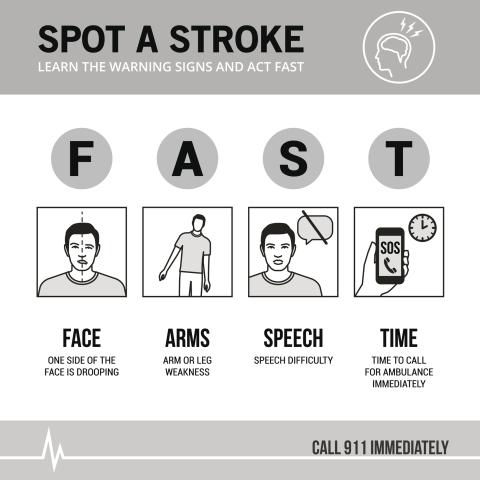Strokes in Adults Under 45
“He’s too young to have a stroke!” is a common line you hear when someone under 45 unexpectedly experiences one. The risk increases with age, but people of any age can experience a stroke. May is World Stroke Month, and this year we’re taking a look at how strokes affect younger adults and how rehabilitation can help them recover.
FAST still applies
You’ve probably heard of FAST—the series of symptoms to look for if you think you or someone else is experiencing a stroke.
- Face drooping: One side of the face might begin to droop or become numb.
- Arm weakness: One arm may become weak and/or numb. If the person tries to raise both arms, one might drift downwards.
- Speech difficulty: Talk to yourself out loud or ask the person questions with simple answers like what’s the date, what did they have for lunch, etc.; a person experiencing a stroke may have slurred or broken speech.
- Time to call 911: Even if these symptoms are very slight or go away after a few minutes, always call 911, even if you aren’t sure if it’s an emergency. Successful recovery from a stroke is heavily reliant on how quickly the person receives medical attention—getting to a hospital as quickly as possible is absolutely vital.
These symptoms are not age-specific; a young adult experiencing a stroke will most likely exhibit symptoms, though the symptoms themselves vary from person to person. Additional symptoms can include confusion, dizziness, numbness, trouble seeing, trouble walking, or a severe headache with no obvious cause. If you note any of these symptoms in yourself or someone else, get medical help immediately.
How strokes in young adults are different
For younger adults (think younger than 45), there are several different kinds of strokes, though they are all caused by a lack of blood supply to the brain. The most common is the ischemic stroke, which is caused by blood clots formed in the brain or a blood clot that travelled to the brain.
For example, 25 percent of strokes in young adults are caused by small tears in a big blood vessel in the neck. The body will form a clot to heal the tear, but if that clot travels to the brain, a stroke can occur. Strokes in younger adults also can be caused by migraines, drugs, smoking, pregnancy, and birth control pills. Heart-related strokes are also common in those under 45—rheumatic heart disease and valve abnormalities are some of the heart conditions that contribute to a stroke.
How to prevent a stroke
Not so surprisingly, obesity is another stroke risk factor in younger adults. Maintaining a healthy weight and body fat percentage will help prevent strokes and keep your heart and brain healthier overall.
As with older adults, blood pressure and cholesterol are big players in the stroke risk of younger adults. Maintaining good levels from an early age can help reduce the risk of a stroke overall. Be sure to keep diabetes and other health conditions under control and properly managed with advice from your doctor.
Recovering from a stroke as a young adult
A young adult who has a stroke may lose decades of productive years and may have a lifetime of rehabilitation ahead of them. 15–30 percent of young adults who experience a stroke are disabled as a result, requiring long-term management of that disability.
However, the brain of a 30-year-old has more plasticity than that of an 80-year-old—plasticity referring to the brain’s ability to adjust and adapt throughout an individual’s lifetime. This means that, typically, younger adults have a better chance of recovery after experiencing a stroke. Adults under 45 are more likely to return to work and live independently.
Rehabilitation isn’t just for “older” strokes
When we think of rehabilitation, most of us think of physical rehab, especially when it comes to younger adults; but rehab options for stroke patients are typically the same regardless of a patient’s age. The only major difference is that younger people tend to have different neurological and social issues.
For example, according to the Canadian Partnership of Stroke Recovery, the presence of young children, marital stress, and the return to work are all issues generally associated with younger stroke rehabilitation rather than older adults who may be retired, widowed, or have independent, adult children.
Rehabilitation for young stroke survivors might emphasize participation in fitness activities, as these are often the activities given up following a stroke—and as we know, lack of exercise can increase the risk of a stroke (or in this case, a stroke recurrence).
And while cognitive recovery rates in younger adults are higher over rates in older adults, cognitive rehabilitation remains very important. In fact, 70 percent of young stroke patients complained of at least one significant disability in work and social functioning due to cognitive impairment post-stroke.
Younger adults also should be sure to highlight socialization and integration back into their families and communities with their medical team to help them have a smoother transition back to their pre-stroke routines.
Strokes in adults under 45 aren’t exactly “common”—only 10 percent of strokes occur in younger adults, but they certainly do occur. Symptoms, causes, and recovery outlook for younger survivors vary, but the common thread in both young and old people is identifying and treating the underlying causes. Reducing risk factors is key in preventing your first or recurrent stroke, regardless of age.
